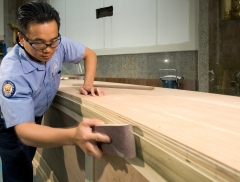
About AOC
Woodcrafting
Woodcrafting

The care and creation of the intricate woodworkings throughout the Congress and Supreme Court is the responsibility of AOC woodcrafters.
Capitol Hill is known for its grand buildings including the iconic daises, committee and member desks along and other intricate woodworking.
The skilled craftsmen who care for these woodworkings use techniques both modern and ancient in their work. This includes large jobs such as the renovation of historic committee hearing rooms and the installation of cabinetry and small jobs such as replacement of missing pieces on a door.
One example of this work is the AOC woodcrafters that help support the U.S. House of Representatives. With the eye of a skilled woodcrafter, the creativity of a Hollywood set designer, and the ingenuity of a Discovery Channel show; this small band of AOC employees is saving taxpayers thousands of dollars and improving the aesthetics of Capitol Hill one mold at a time.
Like a proud parent, Doug Morey, assistant supervisor (and CH-47 helicopter pilot for the U.S. Army Reserve), showcases the amazing work of his talented team, as he points to a delicate and intricate seal found on the front of a Chairman’s dais. The seal has small details such as imperfections in the wood and the marks of a chisel used to carve the eagle’s feathers. Only it isn’t wood—it is a resin replica developed by his team in minutes (and setting overnight). Until you pick it up and actually feel that it weighs mere ounces instead of pounds; you would never know the difference.
Woodcrafters Jerry Rhodes and Joe Buckler, working carefully and quickly together, remove the seal from its mold, laying it on the table—it is an exact replica of the original, developed at minimal cost (less than $20). It is flexible enough to be integrated into the design of cabinetry or around a curved podium, and is beautiful enough to be simply hung on a wall.
Necessity being the mother of invention, this group of employees recognized the need of the House of Representatives to have a flexible solution to its signage—both Member placards and wayfinding signage (restrooms, room numbers, etc.). The contracted solution provided the necessary uniformity and appealing aesthetics, however it was more expensive and it was often difficult to maintain and update the signs.
This innovative process was developed following a suggestion from a House colleague who has seen the technique. On their own initiative, the carpentry shop team received two days of training and developed in-house techniques to replicate the signs through experimentation and their own craftsmanship skills. Reggie Lashley, woodcrafter leader, learned the techniques to replicate exact fonts, Braille, and other features that are then laser carved into the materials that complete the final touches on signage and other features.
Working together on this process, the team has reproduced well over 1,000 signs. Their efforts have resulted in savings over previous solutions that are likely well into tens of thousands of dollars and have achieved great customer satisfaction.




